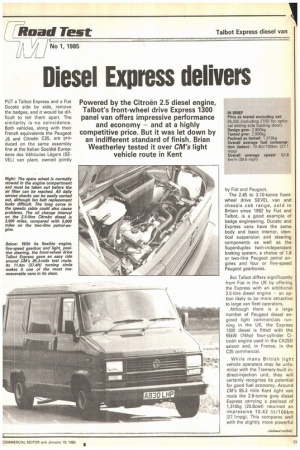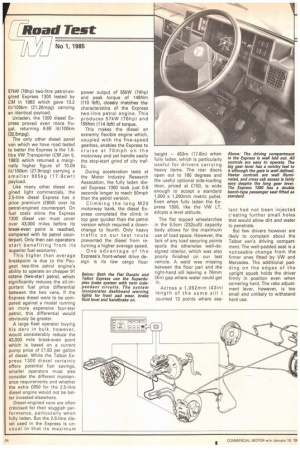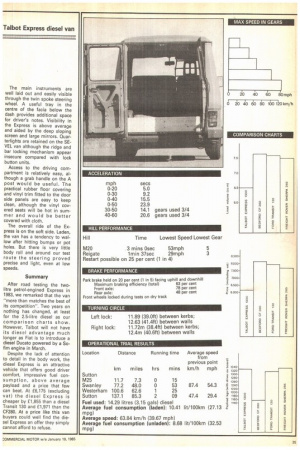Diesel Express delivers
Page 25

Page 26

Page 27

If you've noticed an error in this article please click here to report it so we can fix it.
PUT a Talbot Express and a Fiat Ducato side by side, remove the badges, and it would be difficult to tell them apart. The similarity is no coincidence. Both vehicles, along with their French equivalents the Peugeot J5 and Citroen C25, are produced on the same assembly line at the Italian Societe Europeene des Vehicules Legers (SEVEL) van plant, owned jointly by Fiat and Peugeot.
The 2.45 to 3.10-tonne frontwheel drive SEVEL van and chassis cab range, sold in Britain since 1982 by Fiat and Talbot, is a good example of badge engineering. Ducat° and Express vans have the same body and basic interior, identical suspension and steering components as well as the Superduplex twin-independent braking system, a choice of 1.8 or two-litre Peugeot petrol engines and four or five-speed
Peugeot gearboxes.
But Talbot differs significantly from Fiat in the UK by offering the Express with an additional 2.5-litre diesel engine — an option likely to be more attractive to large van fleet operators.
Although there is a large number of Peugeot diesel engined light commercials running in the UK, the Express 1300 diesel is fitted with the 55kW (74110 four-cylinder Citroen engine used in the CX25D saloon and, in France, in the C35 commercial.
While many British light vehicle operators may be unfamiliar with the Tremery-built indirect-injection unit, they will certainly recognise its potential for good fuel economy. Around CM's 85.3 mile Kent light van route the 2.9-tonne gvw diesel Express carrying a payload of 1,310kg (25.8cwt) returned an impressive 10,42 lit/100km (27.1mpg). This compares well with the slightly more powerful
57kW (76hp) two-litre petrol-engined Express 1300 tested by CM in 1983 which gave 13.2 lit/100km (21.26mpg) carrying an identical payload.
Unladen, the 1300 diesel Express proved even more frugal, returning 8.68 lit/100km (32.5mpg).
The only other diesel panel van which we have road tested to better the Express is the i.elitre VW Transporter (CM Jan 5, 1983) which returned a marginally higher figure of 10.09 lit/100km (27.9mpg) carrying a smaller 9 0 5kg (1 7.8cwt) payload.
Like many other diesel engined light commercials, the 2.5-litre diesel Express has a price premium (f:850) over its petrol-engined counterpart. On fuel costs alone the Express 1300 diesel van must cover over 43,000 miles before its break-even point is reached, compared with its petrol counterpart. Only then can operators start benefiting from its superior fuel economy.
This higher than average breakpoint is due to the Peugeot two-litre petrol engine's ability to operate on cheaper 91 octane (two-star) petrol, which significantly reduces the all-important fuel price differential between the two vans. If the Express diesel were to be compared against a model running on more expensive four-star petrol, this differential would obviously be greater.
A large fleet operator buying his dery in bulk, however, would considerably reduce the 43,000 mile break-even point which is based on a current pump price of £1,83 per gallon of diesel. While the Talbot Express 1300 diesel certainly offers potential fuel savings, smaller operators must also consider the different maintenance requirements and whether the extra £850 for the 2.5-litre diesel engine would not be better invested elsewhere.
Diesel-engined vans are often criticised for their sluggish performance, particularly when fully laden. But the 2.5-litre diesel used in the Express is unusual in that its maximum
power output of 55kW (74hp) and peak torque of 148Nm (110 Ibft), closely matches the characteristics of the Express two-litre petrol engine. This produces 57kW (76hp) and 155Nm (114 ibft) of torque.
This makes the diesel an extremly flexible engine which, coupled with the five-speed gearbox, enables the Express to cruise at 7 Omph on the motorway and yet handle easily the stop-start grind of city traffic.
During acceleration tests at the Motor Industry Research Assocation, the fully laden diesel Express 1300 took just 0.8 seconds longer to reach 50mph than the petrol version.
Climbing the long M20 motorway bank, the diesel Express completed the climb in top gear quicker than the petrol version which required a downchange to fourth. Only heavy traffic on our test route prevented the diesel from returning a higher average speed.
One advantage of the Express's front-wheel drive design is its low cargo floor
height — 453m (17.8in) when fully laden, which is particularly useful for drivers carrying heavy items. The rear doors open out to 180 degrees and the useful optional side-loading door, priced at £150, is wide enough to accept a standard 1,000 x 1,200mm metric pallet. Even when fully laden the Express 1300, like the VW LT, adopts a level attitude.
The flat topped wheelarches in the 6.5cm (232cuft) capacity body allows for the maximum use of load space. However, the lack of any load securing points spoils the otherwise well-designed interior, which was also poorly finished on our test vehicle. A weld was missing between the floor pan and the right-hand sill leaving a 76mm (Bin) gap where water could get in.
Across a 1,092mm (43in) length of the same sill I counted 13 points where sea
lant had not been injected c-eating further small holes that would allow dirt and water to penetrate.
But few drivers however are likely to complain about the Talbot van's driving compartment. The well-padded seat is a noticeable change from the firmer ones fitted by VW and Mercedes. The additional padding on the edges of the upright squab holds the driver firmly in position even when cornering hard. The rake adjustment lever, however, is too small and unlikely to withstand hard use. The main instruments are well laid out and easily visible through the twin spoke steering wheel. A useful tray in the centre of the facia below the dash provides additional space for driver's notes. Visibility in the Express is above average and aided by the deep sloping screen and large mirrors. Querterlights are retained on the SEVEL van although the ridge and bar locking mechanism appear insecure compared with lock button units.
Access to the driving compartment is relatively easy, although a grab handle on the A post would be useful. The practical rubber floor covering and vinyl trim fitted to the door side panels are easy to keep clean, although the vinyl covered seats will be hot in summer and would be better covered with cloth.
The overall ride of the Express is on the soft side. Laden, the van has a tendency to wallow after hitting bumps or pot holes. But there is very little body roll and around our test route the steering proved precise and light, even at low speeds.
Summary
After road testing the twolitre petrol-engined Express in 1983, we remarked that the van "more than matches the best of its competition". Two years on nothing has changed, at least for the 2.5-litre diesel as our comparison charts show. However, Talbot will not have its diesel advantage much longer as Fiat is to introduce a diesel Ducato powered by a Sofim engine in March.
Despite the lack of attention to detail in the body work, the diesel Express is an attractive vehicle that offers good driver comfort, impressive fuel consumption, above average payload and a price that few can beat. At £6,175 (excluding vat) the diesel Express is cheaper by £1,855 than a diesel Transit 130 and 61,971 than the CF280. At a price like this van buyers could well find the diesel Express an offer they simply cannot afford to refuse.














































































